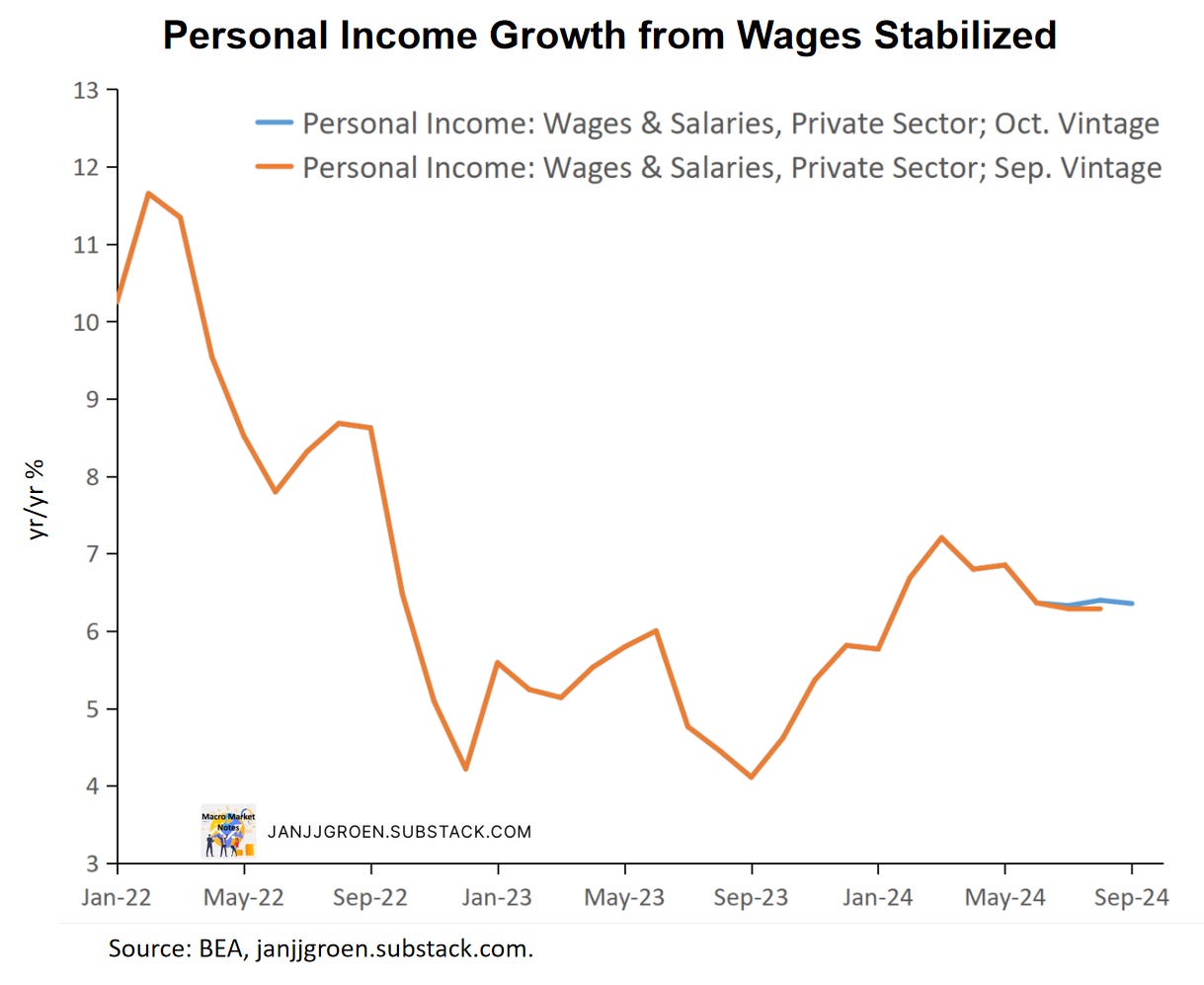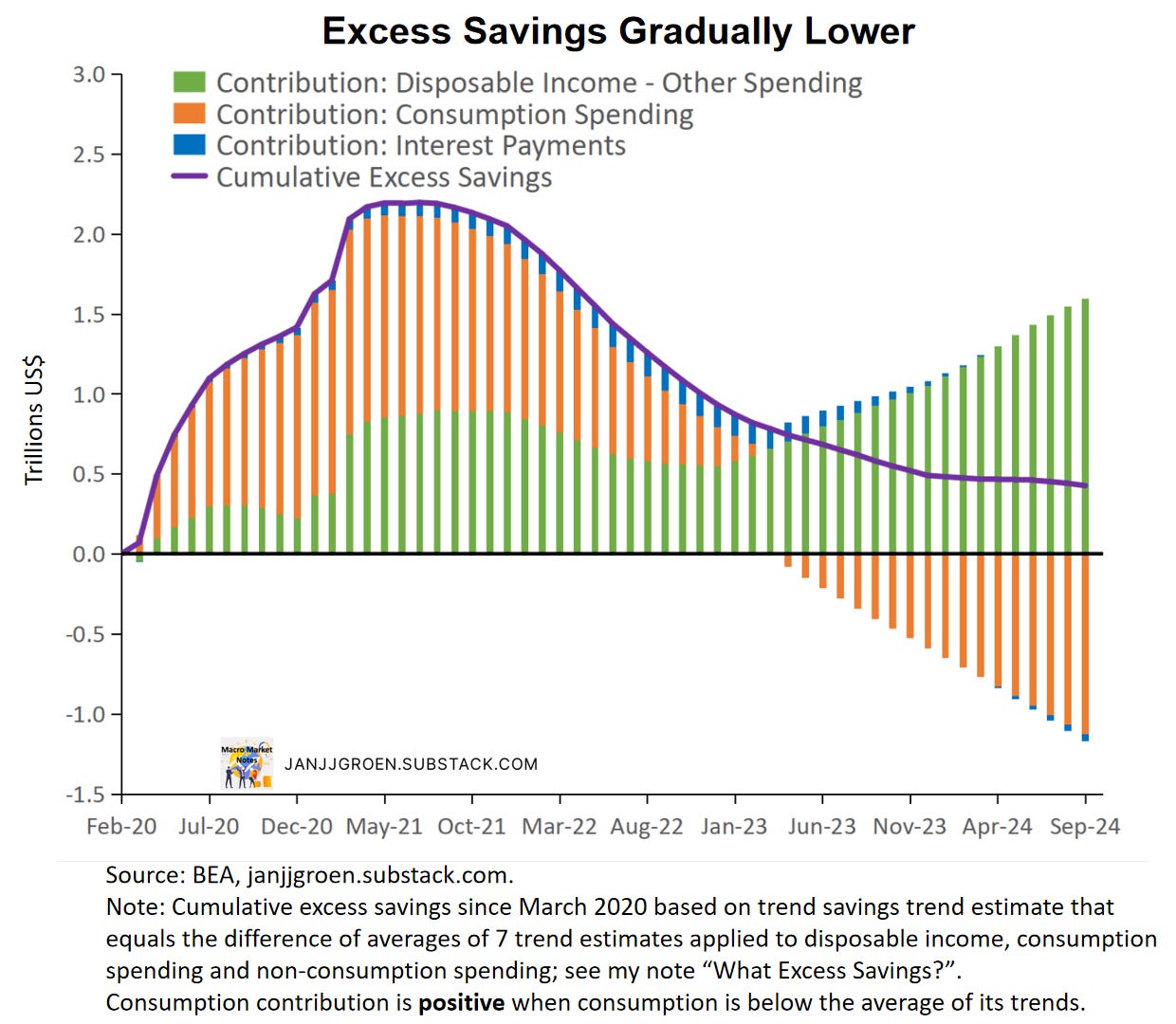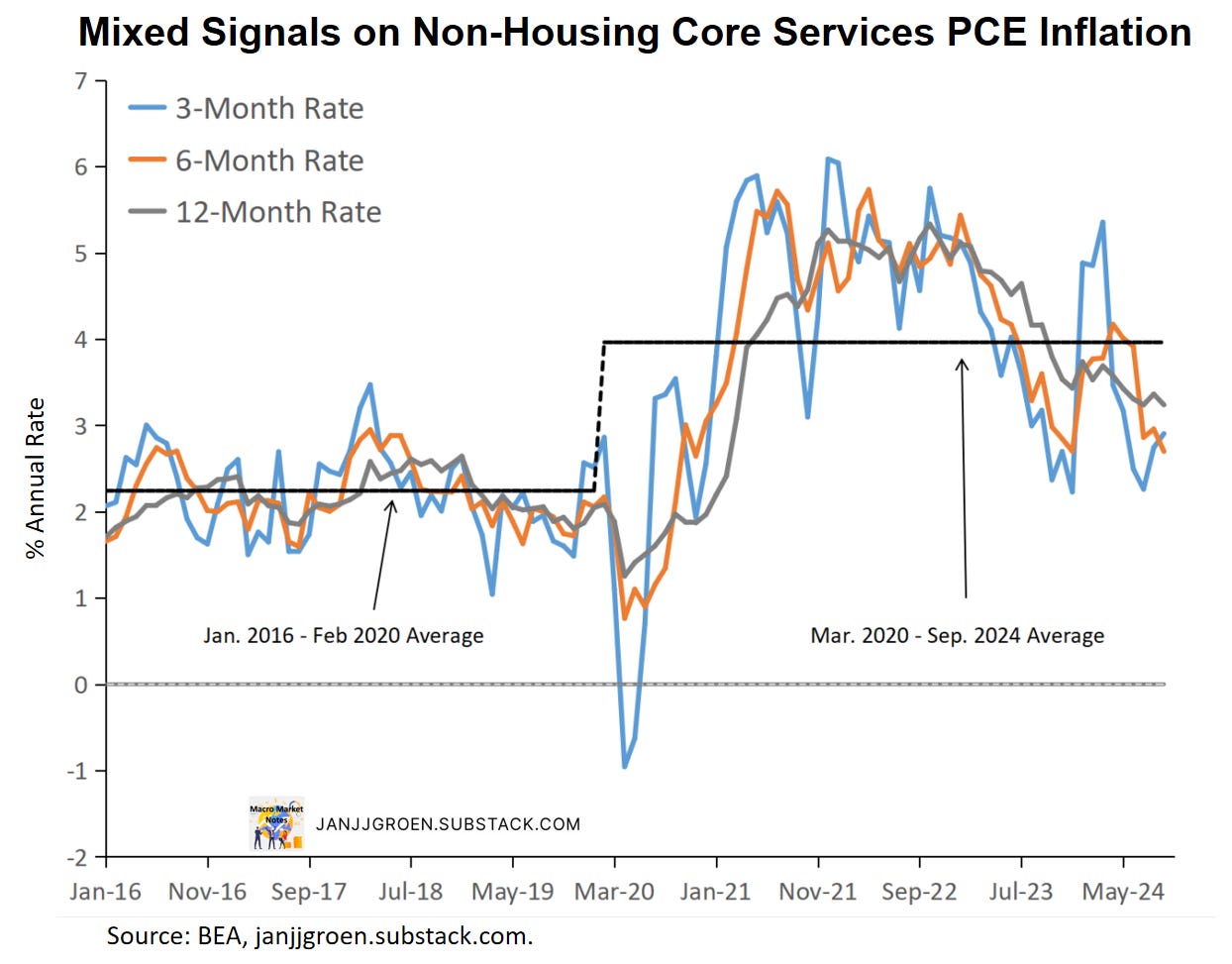Sep Personal Income & Outlays: Keep on Spending
Consumption spending growth remains strong. Near-term trends in underlying inflation rates are at 2% but momentum might be turning upward.
The September Personal Income and Outlays report provides a good insight on the U.S. consumer as well as inflationary pressures going forward. This note presents some of these insights.
Key takeaways:
Personal income growth out of wages and salaries stabilized at a pace not seen since Q3 2022. Household wage income growth continues to overshoot the pace that’s consistent with 2% PCE inflation over the medium-term.
The stock of excess savings has NOT run out and continues to be a tailwind for consumption. Between August and September, it fell around $14 billion and equaled about $426 billion in September.
As in the previous month, in September headline consumption growth ran well above its underlying spending growth. Over the coming months headline spending will likely ease towards the pace of underlying consumption growth. But the underlying pace of consumption spending itself also went up notably in September, likely due to strong household wage income growth and still sizeable excess savings. Consequently, do not expect a large downshift in consumption is forthcoming over the near term.
The central tendency measures of PCE inflation are mostly at 2% on a six-month basis. However, these measures have been accelerating on a three-month basis since August and over an annual horizon underlying inflation still remains above target.
The slowing in underlying inflation measures over the past six months means that Fed officials for now remain willing to continue to cut policy rates. However, given strong wage income and consumption growth rates as well as a recent pickup in underlying inflation momentum, the Fed will be very cautious in easing its policy stance beyond the upcoming November FOMC meeting.
Wage Income Growth Remains Strong
Unlike last month, revisions to the recent path of household income out of wages and salaries were minimal in the September report.
The year/year wage income growth rates in September equaled 6.4%, similar to August (revised up from 6.3% previously - chart above). Household wage income growth has been around 6.3%-6.4% since June, which is only slightly slower than the growth rate for Q1 2024 but notably higher than the wage income growth rates seen throughout 2023.
To interpret wage income growth trends, I earlier proposed to compare wage income growth with a neutral benchmark growth rate based on trend non-farm business sector (NFB) output growth and either the abovementioned common inflation expectations factor or the 2% Fed inflation target. Similar to what I did when discussing wages and inflation expectations in my October 2023 update, I now also incorporate trend labor share growth into this neutral benchmark.
Any deviation in actual household wage income growth above or below the aforementioned inflation target-consistent neutral benchmark means household wage income growth outpaces or cannot sustain in the medium term the 2% inflation target.
The chart above shows that there continues to be a notable wage income growth gap vs the 2% inflation target pace. The extent of the overshoot has been broadly stable since June at a rate not seen since October 2022. This measure has been running in line with the above-inflation target wage growth rates I have been signaling over the last couple of labor market reports.
With nominal wage income growth thus overshooting the pace consistent with the target in the medium term, household spending growth could be an impediment to a sustainable return of inflation to 2% over the medium term.
Households Excess Savings Gradually Lower
Household spending was up 0.5% over the month in September, with disposable household income growing 0.3% for the same period. As a consequence, the savings rate dropped to 4.6% in September compared to 4.8% previously (unrevised).
The chart above shows that over the month the savings rate moved further south of my trend savings rate estimate of 5.4% in September using the ‘average of trend’ approach outlined in my earlier excess savings note (orange line). This trend savings rate estimate remained unchanged compared to August and both the actual and my trend savings rates remain below trend savings rate assumptions used elsewhere (grey and yellow lines).
Above-trend growth in disposable income continues to be a partial offset to the drawdowns in excess savings coming from above-trend growth in consumption spending and interest payments (green bars vs orange + blue bars in above chart). Consequently, in September cumulative excess savings declined from $440 billion in the previous month (revised up from $407 billion) to about $426 billion (see chart above).
Underlying Consumption Growth Moving Higher
As is the case with headline inflation, headline real consumption spending growth often is driven by volatile components that not always reflect the underlying strength of the economy. A core real consumption spending growth measure, therefore, would be really useful, and I do that by approximating such a core measure based on the weighted median across 177 components1 of headline real personal consumption expenditures (PCE). More specifically, the core, or underlying, consumption growth measure equals the growth rate of the real PCE component at the 50% percentile across growth rates of these 177 sub-components of headline real PCE.
The chart above focuses on three-month annualized consumption growth rates. Headline consumption growth has been overshooting the underlying rate since Q1 2024 and this acceleration away from the median consumption growth pace continued in September. However, in September the median three-month growth pace also increased from about 1.6% annualized to 2.2%. So, while we should expect headline consumption growth to cool beyond Q3, as the chart above indicates that headline consumption tends to realign with the median pace when large discrepancies arise, it should do so towards a still very solid pace.
When I compare headline and underlying consumption growth rates on a six-month basis in the chart above, it confirms that the uptick in the three-month median growth rate is likely to persist over the near-term and not ease back. Making the earlier mentioned 2.2% pace a very solid target pace for headline spending to converge back towards.
So, with Q3 headline consumption remaining above trend spending likely will ease somewhat in the coming months. But a large downshift in consumption is not expected over the next six months, as support from strong wage income growth rates, still healthy balance sheets and unspent accumulated excess pandemic savings has moved up underlying consumption growth as well.
Underlying Inflation Rates at 2% in Near-Term
In terms of inflation, core PCE inflation accelerated in September to about a 3.1% annualized monthly rate from 1.9% in August (upwardly revised from 1.6%). Core goods inflation no longer was negative at +1.3% annualized month/month, up from -2.1% in August (downwardly revised from -1.1%), whereas core service inflation picked up to 3.7% annualized month/month in September from an upwardly revised 3.2% in the preceding month.
The Fed’s favorite gauge of underlying inflation, core services excl. housing PCE inflation, also accelerated from (an upwardly revised) 2.4% annualized month/month in August to about 3.6%. Given the large volatility in this measure since the pandemic it seems worthwhile to smooth through noisy month-over-month dynamics.
The chart above plots three-, six- and 12-month annualized inflation rates for the non-housing core services PCE deflator. The average annualized monthly rate still reads about 4% for the post-COVID era (black dashed line), two times the average rate we observed for the immediate years pre-COVID.
The momentum measures in the chart above have been sticky around 4% for most of 2023. Since April of this year, momentum in this non-housing core services inflation measure slowed again and this slowing became more pronounced over the past couple of months. However, while six- and twelve-month inflation rates eased again this month, the three-month inflation rate has been accelerating since August. This could mean we have bottomed, and momentum might be rising again going forward. Something to keep an eye for the remainder of the year.
Instead of focusing on whether specific components of inflation should be ignored or not when assessing underlying inflation trends, one could focus on the central tendency of consumer price inflation, a.k.a. the center of the distribution of all price changes unaffected by extremely volatile consumer price components. This could potentially provide a better sense of the target toward which inflation moves over time once those excessively volatile price changes have stabilized.
Such measures of central tendency for the PCE price indices use a variety of trimming procedures to weed out excessive volatile components of these price indices in a given month2:
Median CPI, which takes the inflation rate of the component at the 50% percentile of the CPI component price changes.
Trimmed Mean PCE (Dallas Fed), where the highest 31% and lowest 24% of PCE component price changes are dropped.
15% Trimmed Mean PCE, where the highest 7.5% and lowest 7.5% of PCE component price changes are dropped.
20% Trimmed Mean PCE, where the highest 10% and lowest 10% of PCE component price changes are dropped.
30% Trimmed Mean PCE, where the highest 15% and lowest 15% of PCE component price changes are dropped.
To get a sense of near-term trends in underlying PCE inflation I look at six-month averages of the annualized percentage point deviation of the above monthly central tendency inflation measures relative to their values as implied by 2% core PCE inflation. This is also consistent with public statements by Fed officials that they’d like to see sustained progress of inflation converging back to target, as measured over months and quarters of inflation progress.
The six-month average deviations of underlying PCE inflation rates relative to the inflation target in the chart above have declined notably over the last couple of months and, with the exception of Median PCE, are now aligned with the Fed’s inflation target. Going forward, however, it is not clear whether this will be sustainable. The chart below looks at three-month average deviations across the underlying PCE inflation measures, and across all measures these have been firming over the past two months signaling broad-based support for the pick-up in core PCE inflation. Of course, this could simply be reflection of the near-term trend settling at 2% or, alternatively, we’re passed the bottom and again on an upward sloping trajectory.
Over a somewhat longer horizon the underlying trends still remain above the 2% inflation target. The 12-month average deviations of underlying PCE inflation rates relative to the inflation target in the chart below still remain close to 2.6% in September, signaling that a potential return to target will likely not happen until well into 2025, if at all.
From the perspective of the Fed underlying inflation rates have shown enough progress of the past six months for Fed officials to be comfortable with continuing to cut policy rates. However, given still strong underlying spending growth, a pace of wage income growth well above the pace consistent with the inflation target, and an uptick in underlying inflation momentum, the Fed will be very cautious in easing rates beyond the upcoming November FOMC meeting.
For a description of these 177 components, see Appendix A in the Dallas Fed trimmed mean PCE inflation working paper, where I use the corresponding real quantities instead of the price indices.
The trimming is based on the inflation rates of 177 components of the PCE deflator, see Appendix A in the Dallas Fed trimmed mean PCE inflation working paper,













